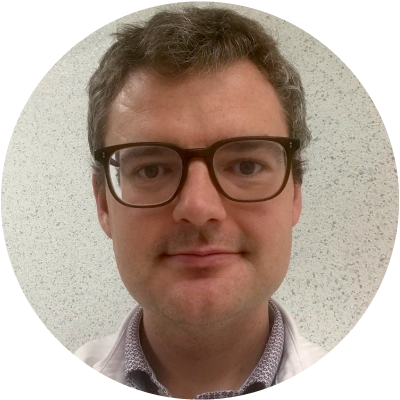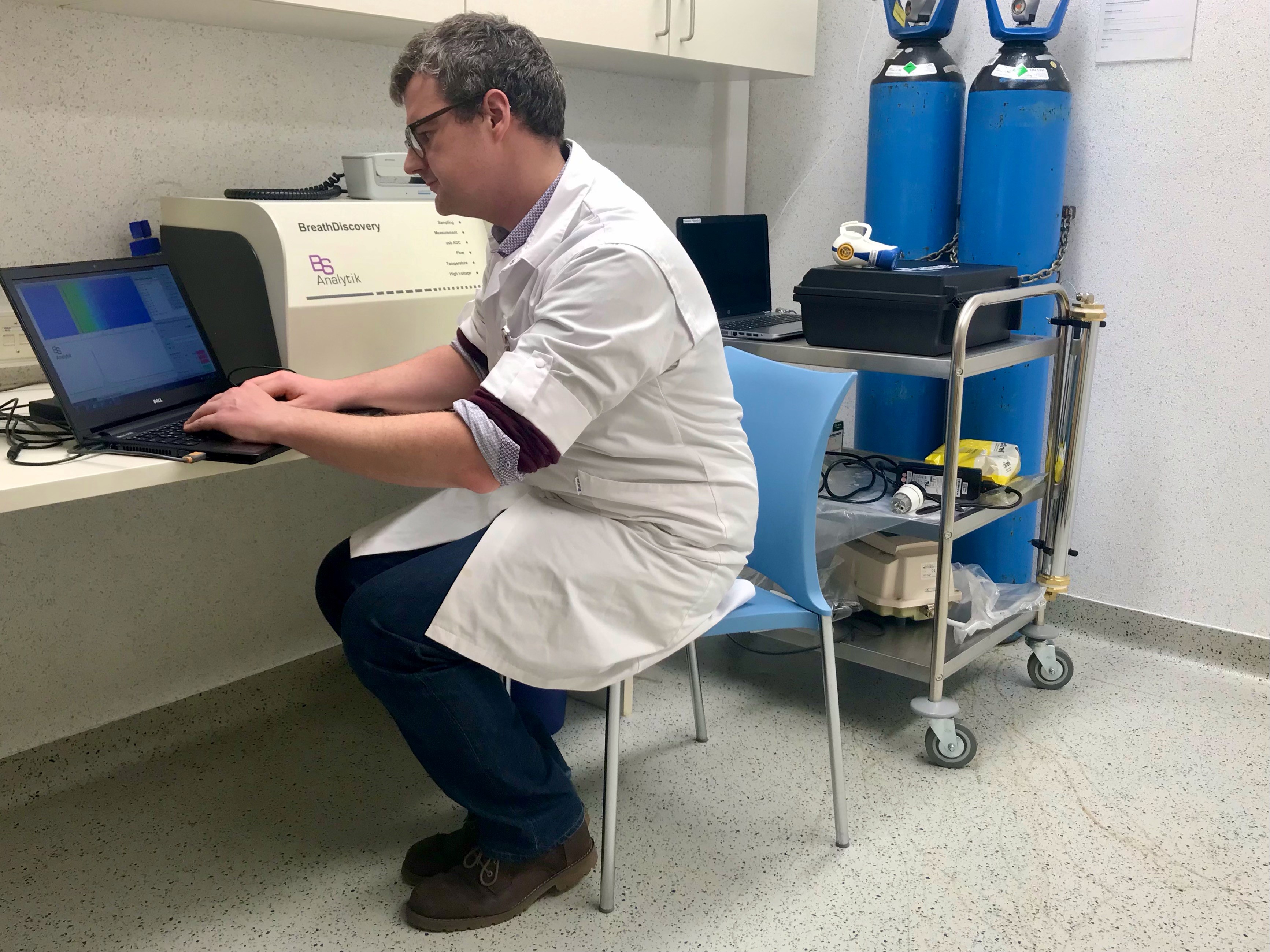Leaders in the Field: Kevin Lamote on building a career in breath research
Published on: 22 Nov 2021

Kevin’s set up his own breathomics facility in Antwerp and is beginning to build a research legacy of his own. His early research interests were in inflammation in general and respiratory diseases but he’s now leading studies across a diverse range of areas. Throughout our interview Kevin spoke with an infectious enthusiasm as he told us a bit more about his journey so far, his current priorities and his advice to others interested in working in breathomics.
Can you tell us a little bit about your career to date and how you came to enter the field of respiratory medicine?
I graduated as a biomedical scientist at Ghent University, and wanted to go into research. There was an opportunity at the Ghent University Hospital in the team of Prof. Jan van Meerbeeck, who was looking for biomarkers for mesothelioma and lung cancer. He is a renowned researcher and had already done some work looking into blood-based biomarkers, but the results hadn’t been strong enough for use in screening programs. He was interested in exhaled breath as a new field to explore biomarkers, and that was a topic that I was attracted to.
In 2006, I started my PhD, trying to set up a breath sampling facility at the University, with an initial focus on mesothelioma and then pulmonary diseases in general. After four years our team had generated some very interesting results.
Jan van Meerbeeck left Ghent University Hospital in 2015 and, in 2017, I joined him at Antwerp University, where I am now a postdoc working on breath analysis within the Laboratory of Experimental Medicine and Pediatrics, a laboratory that combines basic, translational and clinical research across multiple clinical disciplines, specifically focusing on inflammation. This is a good fit for me, given the connections between inflammation and volatiles that have already been established. I’m getting the opportunity to set up a breathomics facility, to do all kinds of volatile research and explore volatomics in general, and in relation to specific diseases.
So, your initial focus was in respiratory but now you’re looking across the whole system?
Yes, next year we will start a clinical trial to determine the clinical utility of a biomarker panel for mesothelioma to see if we can really improve detection in early stages and consequently the patients’ survival rate. We are already running or have plans for studies in neonatal intensive care, gastrointestinal diseases, cardiology diseases and pneumology – and a side project looking at diabetes! We have even more ideas for the future!
Why is the search for breath-based biomarkers such an exciting area to be working in at the moment?
It is exciting because it will allow us to study the dynamics of these volatiles in a way which is currently lacking in the field. At present, breath research lacks knowledge of the origins of volatiles and their roles throughout the body. Where are they formed? Where do they get absorbed or get transformed? How do they get metabolized? Why does what you see in breath differ from volatiles seen in other human samples? Getting more information and knowledge about the dynamics of the volatiles will help us firmly establish biomarkers for specific diseases in the future.
Breath analysis is a field that will have a high impact, once we have results that can be used in the clinics, because of its non-invasiveness and the ease of sampling. I don’t think volatiles will completely change the way clinics work, becoming the single diagnostic gold standard, but I see a great promising use alongside other biopsies as a companion diagnostics tool.
What it’s been like working with Jan and how has he influenced your career?
Jan van Meerbeeck is considered a global authority in thoracic oncology, so he has a really big network. That skyrocketed my career, allowing me to discover technologies, get samples and really grow my own network in that field. When he came to Antwerp, I was still at Ghent. He was still a dedicated supervisor, but he also allowed me to have independence. That was really hard work, but by allowing this independence, he really prepared me for postdoctoral work and I’m very grateful for that. He taught me how to make deadlines, how to plan experiments and how to write grants. He also supported and encouraged me to go to several conferences, like ERS (European Respiratory Society) and the Breath Summit, every year. That helped me find people with the same interests, build my own network, and grow into the role I have today.
Jan is now enjoying his emeritate but is still affiliated to the university and hospital and still sees some patients every week. We keep on working together and write grants together, but I feel our relationship has changed from being his PhD student to more of a colleague. We talk together about ideas and try to work them out. He’s still a big part of my work and the initial research he started is still evolving.
A lot of studies report tentative ideas for prospective biomarkers. How important do you think it is for the future of breath research to be able to definitively verify these IDs?
Some people say IDs are not important, that a physician doesn’t need to know what’s behind a test result to make a diagnosis, but identifying volatiles is important because you can then trace the potential origins of the compounds. Could it be linked to a pathway that is involved in the specific disease of interest? Or, is it more likely to be a general marker for inflammation. That’s interesting and useful to know.
In order to create an approved handheld device, you need to know the biological link between what you measure as a volatile and your disease of interest. If you can ID your compounds, in the future you might be able to make targeted handheld breathalyzers, sensitive to the compounds of interest.
More recently, how has the COVID-19 pandemic affected your research? Has it altered your priorities over the last two years?
Here in Belgium, breath is considered a human material, so what you exhale must be registered to a biobank and you need ethical approval to take a breath sample, limiting large-scale breath analysis studies. When COVID arrived, breath was considered as the most infectious matrix by the ethical committee, who stopped all breath research immediately. This pushed us to refocus our research by asking ourselves how to sample breath safely without any risk of cross-contamination. What we could do was very limited.
We decided then to focus on our in vitro work and headspace analysis of other samples (stool and urine). With the vaccination program in place, we are now trying to restart the inclusion of patients again but it’s not fully up and running yet, and we are not sure what measures will be taken in the new Covid waves. It has really affected our research.
“We are glad that there are companies like Owlstone that want to help drive the research in this field.”
When did you first come across Owlstone Medical and in what context?
The first time I heard about Owlstone was quite a long time ago when the breath research society wanted input to develop a standardized breath sampler. I remember you brought a prototype of the ReCIVA Breath Sampler to the IABR Breath Summit, but since then you have really kept going on at full speed. We are glad that there are companies like Owlstone that want to help drive the research in this field.
It’s not long until this year’s Breath Biopsy Conference [BBCon is Owlstone Medical’s annual flagship event]. A number of our students will be attending, and we have submitted some abstracts for presentation too.
Kevin was interviewed prior to BBCon21. You can now view this year’s presentations on demand and express interest in attending next year’s conference on our dedicated event page.
What do you hope to achieve in the long term? And what do you think are the biggest challenges to making that happen?
We are working towards a few different things at the same time. We’d like to have a platform that can accurately identify and validate biomarkers, and at the same time tell you about the kinetics of the experiment. We’d also like to create a database of volatiles where all the information available is stored, as already exists for fields like proteomics. Ultimately the dream is to change the clinic, to develop a breathalyzer for a certain disease and have non-invasive tests in the clinic that are used either for diagnosis or for treatment monitoring as companion diagnostics.
Standardization is one of the biggest hurdles to achieving that. There are so many different matrices that you can sample, all with different techniques, each with their own difficulties. Related to that, the effect of environmental volatiles on the composition of what you exhale needs to be better understood in the future, alongside standardization of how we handle background volatiles in general.
“If you want to have a career in breath, you have to believe in it. You have to dare to think of possible solutions and not get discouraged if something doesn’t work well in the beginning.”
What would your advice be to anyone interested in building a career in breath research?
Go for it! It’s a really interesting field to be in. Compared to other fields it’s relatively new – so you’ll be working in a field that’s in progress, it’s skyrocketing, but it’s still small enough to easily get to know people and make connections. All the key players are reachable and very eager to help and to learn.
If you want to have a career in breath, you have to believe in it. You have to dare to think of possible solutions and not get discouraged if something doesn’t work well in the beginning. It’s very multidisciplinary, there’s a lot to learn and it’s never boring. You have patient contact and you take samples, but you can also do lab work and look at other kinds of other samples, so it’s really a nice mix. There are so many different things you can explore in breath and volatile research, from the fundamental science all the way through to the clinic.
If you have a dream in a breath analysis, just do it. You might be one of the pioneers that will develop the breathalyzer of the future!
If you’ve enjoyed this entry in our ‘Leaders in the Field’ series of in-depth conversations with influential people currently working in breath research, why not check out our other recent interviews? We’ve previously spoken to Professor James Covington, a leading voice in VOC biomarker research and Professor Rick Yost, a pioneer of the triple quadrupole mass spectrometer.

